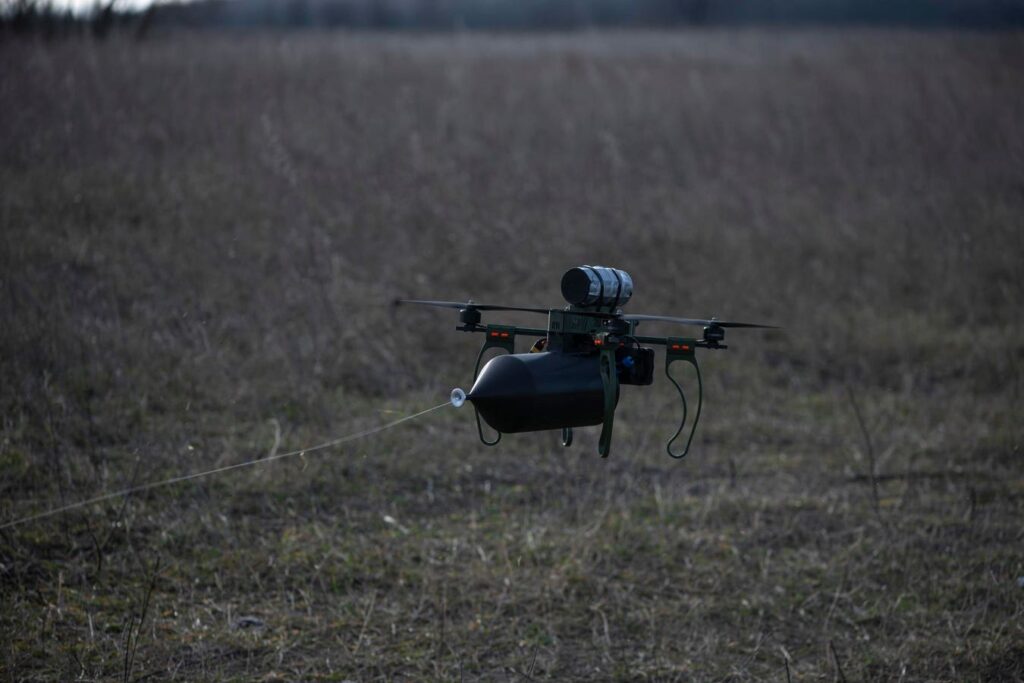On the Chinese ecommerce giant Alibaba’s online shopping platform, with a couple of clicks, Americans and Europeans can order one of the latest deadly innovations from the battlefields of Ukraine: fiber-optic control equipment that makes drones impervious to electronic jamming or remote takeover.
That’s a worrying development for domestic law enforcement agencies, which rely on those methods to deal with rogue drones that fly near airports or stadiums.
For under $300, an armchair shopper on Aliexpress can buy all the gear needed for a pilot to control a drone using a spiderweb-thin fiber-optic wire rather than radio signals. The main element: a cylinder that will pay out as much as 18 miles of cable as the drone flies. Suitable fiber-optic cabling can also be bought in bulk on Amazon, without the necessary spool to load it on a drone.
“If you want to start your own air force, you can order everything you need off of Amazon and Alibaba,” said Troy Smothers, cofounder of a U.S. volunteer group called Drone Reaper that’s developed an affordable fiber-optic control system for Ukrainian drones. “It’s right there — we did it.”
While many sellers of fiber-optic spools on Aliexpress tout civilian uses for the technology, like inspecting the inside of tunnels or pipelines, that’s just a smokescreen, said Robert Bunker, who tracks illicit use of consumer drones as director of research at the consultancy C/O Futures. “It’s kind of implicit it’s to fly drones in [jammed] environments.”
At least one listing makes the connection to the Ukraine war explicitly, showing a picture of a fiber-optic controlled drone equipped with what appears to be a rocket-propelled grenade.
Bunker, who consults with law enforcement agencies on counterterrorism and threats from new technologies, said he was concerned the equipment could easily be picked up by bad actors in the United States. At “major sporting events where jammers have been deployed by federal law enforcement, extremist or terrorist drones would be immune to such jamming and takeover countermeasures.”
U.S. military units deployed overseas can blast hostile drones from the sky with missiles or rapid-fire cannons. Stateside, such weapons aren’t used due to the risk of injuring bystanders or damaging private property. When faced with drones that enter flight-restricted areas like airports or stadiums hosting major sports events, federal law enforcement agencies rely on detecting the radiofrequency transmissions between the drone and its controller to pinpoint their locations. To take drones down, the favored method is to override the control signal and force the drone to land.
Those techniques wouldn’t work on fiber-optic controlled drones. It would also negate the geofencing that makers of commercial drones like DJI install that precludes operators from flying into restricted airspace around airports, power plants and government buildings. Among the defensive measures that would still work are systems that catch unmanned aircraft in nets. There are portable launchers that fire fabric that snares a drone, with a parachute attached so it then floats safely to the ground, and hunter drones that catch smaller ones in nets midair and tow them away.
The Federal Aviation Administration and Department of Homeland Security did not respond to requests to comment before publication of this article.
In Russia’s war on Ukraine, both sides are making deadly use of small, inexpensive quadcopters loaded with explosives that are crashed into targets by pilots using first-person view goggles. Since 2023, as the conflict slowed into trench warfare across much of the battlefield, both sides increased their use of jamming. It’s been effective – electronic warfare reportedly stopped as many as 75% of drones last year.
That led to experimentation with fiber-optics, in which pulses of light move through strands of glass to transmit commands to a drone, and the video feed from the drone’s camera comes back the other way through the thin cable. Russia reportedly fielded a model last summer dubbed Prince Vandal. Inspired by a Forbes article on another Russian prototype, Drone Reaper’s Smothers started working on a solution for Ukraine. A former U.S. Marine rifleman who had trained with Ukrainian soldiers in the early 2000s, Smothers cofounded Drone Reaper after the war broke out to raise money to buy unmanned aerial vehicles for Ukraine.
In three months, Smothers and a team of volunteers developed a fiber-optic control system suitable for a 10-inch drone with 6 miles of cable that he said required $250 worth of materials, including equipment to convert electrical signals to optical and back. First tested in combat by the International Legion, a unit of foreign volunteers, Smothers said that over 90% of the time, drones equipped with the system are hitting their target.
Smothers said the Drone Reaper team has since developed a simpler version with materials that cost under $100.
Federal and state agencies have reached out to discuss the technology, he said.
“What makes it so lethal and such a concern is the fact that it’s at a price point that adoption is not prohibitive.”
Read the full article here


